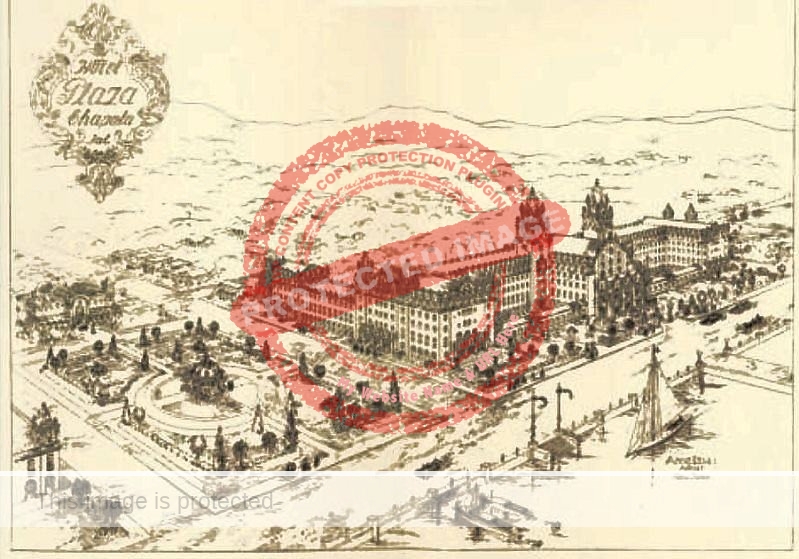This beautiful architectural sketch for a major railroad and hotel complex in Chapala offers intriguing insights into plans at the start of the twentieth century to transform Chapala into an international tourist destination.
The drawing is dated 1912. This is despite the fact that the company that eventually built the La Capilla-Chapala railroad was not formed until five years later. Construction of the railroad and station began in 1917, and was completed by 1920; the inaugural passenger service was on 8 April 1920.

Arne Dehli. 1912. Sketch of Hotel Plaza, Chapala.
The person who commissioned the drawing, and was the main promoter of the company that built the railroad, was Norwegian-born entrepreneur Christian Schejtnan. The author of the sketch was Norwegian-American architect Arne Dehli (1857-1942). Dehli, born in Ringsaker, Norway, trained in Germany before moving to New York to design churches, the nurses’ home for the Norwegian Hospital, various business structures, some private residences, and the zoological building in Prospect Park, Brooklyn. The Norwegian link presumably explains why Schejtnan wanted Dehli to be involved in the project.
We can also safely assume that Schejtnan made good use of the drawing in his pitches to potential Norwegian investors. His sales pitches extolled the virtues of the railroad and how building a first class hotel would turn Chapala into Mexico’s largest tourist and health resort. Additional revenues would come from building private villas, a combined yacht and automotive club, and a casino. In short, Schejtnan’s master plan would create “an El Dorado for the country’s richest, a sought-after place for the country’s jeunesse dorée.” (Brøgger) Norwegians were sufficiently entranced with Schjetnan’s dreams for this remote lake on the other side of the world that they happily parted with tens of thousands of dollars. Sadly, most investors reportedly lost their shirts long before the railroad ever came into being.
The master plan was far too ambitious to achieve all at once, and, in any case, Schejtnan was always short of investors and working capital. For the railroad line itself- his top priority- Schejtnan imported a young Norwegian railroad engineer, Birger Winsnes, to oversee the work of laying the track; Winsnes worked in partnership with Guadalajara engineer Juan José Barragán, the brother of famed modernist architect Luis Barragán.
It is possible that Schejtnan always hoped to have Dehli design the railroad station, his second priority. But, with funds tight, he finally settled on asking a near neighbor in Chapala—engineer Guillermo de Alba—to draw up the plans for the station.
Dehli remained in the picture, though. And four months after the railroad opened, Guadalajara press reported that he had been chosen by Schejtnan to design the luxury Hotel Plaza, intended to be the centerpiece of an extensive residential development.
Sadly, Schejnan’s and Dehli’s plans for the Hotel Plaza never progressed beyond the drawing board. A copy of Dehli’s plan is in Mexico’s National Water History Archive (Archivo Histórico del Agua) in Mexico City.
For more about Christian Schetjnan, Guillermo de Alba, and the short-lived glory of the Chapala Railroad Station, see If Walls Could Talk: Chapala’s Historic Buildings and Their Former Occupants (available in Spanish as Si las paredes hablaran: Edificios históricos de Chapala y sus antiguos ocupantes).
Sources
- Kenneth Bjork. 1947. Saga in Steel and Concrete: Norwegian Engineers in America. Norwegian-American Historical Association.
- Magnus Bjørndal. 1931. “Arne Dehli,” in Norwegian-American Technical Journal, vol. 4, no. 1, p. 12 (April, 1931).
- El Informador: 11 August 1920.
- Brøgger, Kr. Fr. 1932. Gullfeber ‑ en advokats optegnelser fra siste jobbetid. (Gold Fever – A Lawyer’s Records from the last job.). Forlagt av H. Aschehoug & Co (W. Nygaard), 63-64. [translation by author]
- Museo CJV (Claudio Jiménez Vizcarra). “Vista del lago. Hotel Plaza y Estación del Ferro Carril en Chapala Jalisco.”
Comments, corrections or additional material related to any of the writers and artists featured in our series of mini-bios are welcomed. Please use the comments feature at the bottom of individual posts, or email us.
Tony Burton’s books include “Lake Chapala: A Postcard History” (2022), “Foreign Footprints in Ajijic” (2022), “If Walls Could Talk: Chapala’s historic buildings and their former occupants” (2020), (available in translation as “Si Las Paredes Hablaran”), “Mexican Kaleidoscope” (2016), and “Lake Chapala Through the Ages” (2008).